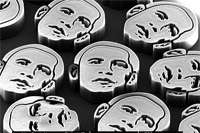'Nanobamas' fuse art, science, technology and politics

(PhysOrg.com) -- A University of Michigan professor has created 3-D portraits of the president-elect that are smaller than a grain of salt. He calls them "nanobamas."
John Hart, an assistant professor in the Department of Mechanical Engineering, made the mini-Barack Obama likenesses with his colleagues to raise awareness of nanotechnology and science.
Each one contains about 150 million carbon nanotubes stacked vertically like trees in a forest. A carbon nanotube is an extraordinarily strong hollow cylinder about 1/50,000th the width of a human hair.
"Developments like this are an excellent way to bring the concepts of nanotechnology to a broader audience," said Hart, who made the portraits with his colleagues by working late on a Friday evening. "Also, we thought it would be fun."
Carbon nanotubes could be used in solar cells and batteries, new methods of diagnosing and treating disease, next-generation computer processors and memory, and stronger lightweight materials. Hart's Mechanosynthesis Group focuses on studying how to make nanostructures like nanotubes, and how to use these small-scale building blocks in electronics, energy devices and high-performance materials.
To create the nanobamas, the researchers converted Shepard Fairey's famous red, white and blue poster of Barack Obama to a line drawing. They shrunk it and printed it on a glass plate with a laser to create a mask. They shined ultraviolet light through the masked glass plate on to a silicon wafer to create the pattern. Then they grew the carbon nanotubes on the pattern, using a high-temperature chemical reaction.
The researchers photographed the nanobamas with an electron microscope. The faces are half a millimeter in size.
Nanobama is Hart's latest artwork too small for the naked eye to see. His complete gallery is at nanobliss.com, a site he started in 2006, inspired by the beauty in the structures he was building for his dissertation. Hart has used this technique to make Michigan logos, snowflakes and a mock Absolut Nano ad that shows nanotubes grown in the shape of a vodka bottle.
Provided by University of Michigan





















